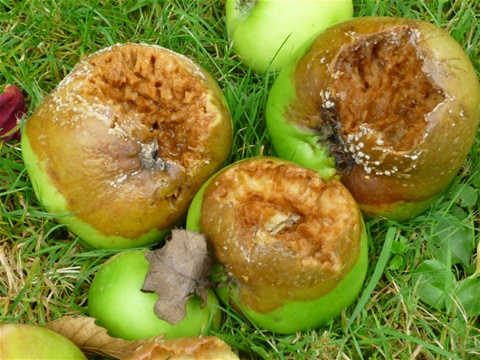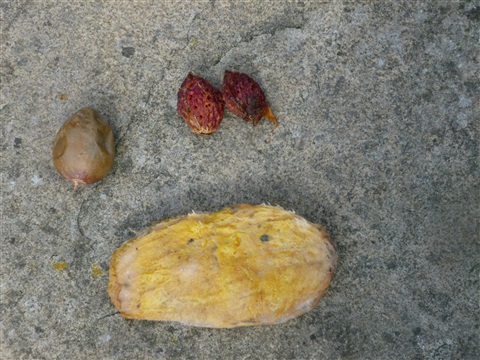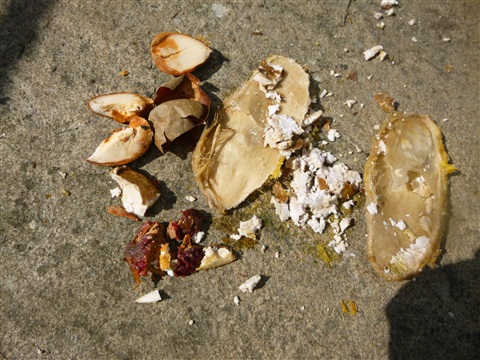Composting Apples
As it is becoming customary to celebrate Apple Days across the country including the pressing of apples to make juice I felt it might be useful to expand the advice on composting apples.
Any composter who does not have their own fruit trees or access to the pulp from an apple day may find that the local allotment, community garden, local park or farmer with a small orchard may be happy to allow the collection of bruised or rotting windfalls. In towns a local juice bar may be pleased to have the pulp removed for free.
Under normal circumstance apples can be added to the composting as and when they are no longer suitable for eating and this includes the occasional windfall during the summer months. Chopping the apples will of course speed the composting process. However in the autumn larger numbers become available together with the mushy pulp resulting from juice extraction a slightly different approach is needed to deal with the sudden influx of “greens” into the bin or heap. If creating compost heap or using a New Zealand bin the minimum size recommended is 3cu feet. Smaller heaps will breakdown more slowly and will need more frequent turning to keep the composting process working.
Where there are a lot of apples it is best to layer them with browns and continue making alternate layers of apples and browns until all the windfalls have been used. If you only have a few trees it might be better to collect the apples in some kind of storage container i.e. a bucket or bin so that you have enough to make several layers about 4” thick at the same time. If possible other greens should be added at the same time as the chopped or pulped apples to introduce air spaces and variation into the green mix.
Creating the correct green brown ratio is important so as to prevent the apples fermenting and producing an unpleasant smell. One part green to two part brown material is recommended but if the fruit is going to form a high proportion of the compost heap the addition of a bulking agent to absorb the liquid and provide plenty of free air spaces (FAS) to maintain aerobic decompostition is recommended. For more details on bulking agents please see the page on Food Composting.
Although autumn leaves are normally used to make leaf mould they do make an excellent component of the brown layer. Sawdust from a vegetarian pet, such or chicken can also be added. I also add shredded computer paper. The high liquid contentof fruit pulp makes an excellent wetting agent for dry hay and sawdust A shovelful of finished compost from an adjacent bin, plain garden soil or manure can be added to kick start the microbial activity that will turn the apple waste into quality compost. As with most hot composting systems water the bin or the browns at the start of the process and at any time that it looks dry. Turn the compost mix to aerate it and cover with browns (I use the shredded paper) as this will reduce any smells from the bin and reduce numbers of fruit flies when the lid is removed or heap uncovered
For the first week the material should be turned daily to aerate the material ensuring that microbial activity heats the content. When turning move the material on the outside of the pile toward the center. This can be reduced as the effect decreases. See the section on hot composting if you have a thermometer monitoring the temperature it can provide additional interest (especially for children).
Do continue to check the compost condition of the bin weekly. If it becomes to dry it will stop working while if too wet anaerobic bugs will take over and the temperature will fall and the smell will increase. If dry add water a little at a time, if wet add more browns e.g. dry leaves. After two or three months the compost should be finished dark brown in colour with an earthy smell and no apples identifiable.
Cold Composting Apples
If you have fewer apples and intend to add them to a bin already in use a simplified techniques can be used.
If the apples are whole chop them with a spade and add to the bin to make a layer two or three deep. Cover this with a wet leaves, bedding from vegetarian pets, rough compost or old straw. Repeat the process adding apple and brown layers until the apples have been used. Finish with a layer of browns to reduce odours and insect pests. Using this cold composting process it may take up to two years to produce good quality compost
When using cold composting techniques the pile will not get hot enough to sterilize the apple seeds, or you might jfind that an orchard is being sown when the finshed compost is spread .
Trench Composting apples
Apples can also be trench composted where space is available in the garden to dig and leave the trench for two years for the apples to decompose. A trench is dug across the garden at least twelve inches deep; a depth of two spits is often used. The soils removed is placed allow the side of the trench. A four to six inch layer of apples can be put into the trench and covered with the soil removed when digging the trench. This will create a small mound which will sink as the apples decompose. Traditionally runner beans or marrows are planted on the trenches. If being used for marrows, squashes or beans planted in wigwhams the circular "trench" can be dug rather than one across the plot.
Composting Apple Pulp
Although fruit pulp is not nutrient rich in itself, the fruit seeds contained in it contain nitrogen, phosphorus, and other plant nutrients that would normally provide nutrients for the germinating plant. This will be a useful addition to the compost heap.
In general food waste has a high moisture content and as it is broken down water is released into the composting vessel and as a result the structure of the composting material will not contain sufficient air spaces for aerobic composting and the food will decomposes into a wet, smelly sludge. This can be avoided by the use of a bulking agent to add structure (or bulk) to the compost and create air spaces allowing air to circulate within the composting material. A good bulking agent will also absorb the liquid from the food to maintain the correct moisture content of the food waste during composting.
In the case of fruit pulp, the need for an effective bulking agent is even more important as we are starting with a wet mushy sludge that will not compost aerobically without the addition of a bulking agent to provide carbon and an open structure. I would recommend mixing sawdust with the pulp to absorb most of the liquid before adding an additional bulking agent such as woodchip to provide air spaces allowing the composting bacteria to work aerobically. If possible, mix the pulp and bulking agent before adding to the compost bin to ensure a through mix. The addition of shredded paper or corrugated cardboard may also be beneficial
I have included more detail on the use of bulking agents when composting food in the page on food composting.
Apple Pulp added to a wormery
Apple pulp can also be added to the wormery as it is wet and almost liquid in form it will be easy for the eat and the large surface area, compared with a whole or segmented windfall apple will result in faster microbial decomposition but the pulp will need to be supplemented with other food to provide a balanced meal.
Anaerobic fermentation can also be problem unless most of the liquid is removed by prior to adding the pulp to the wormery. An easy method of achieving this is to put the wet pulp in a cotton pillow case or bag and allow it to drain, or squeezing it, to remove most of the liquid. A bag with handles is easy to hang up to drain or squeeze
The material left after draining can be added to the wormery in thin layers between or mixed with paper or cardboard to absorb additional moisture. The fruit pulp should be covered with the paper or cardboard to reduce the fruit fly population that will accompany the addition of fruit to the wormery or compost bin.
Composting Plums
I used to have more windfall plums than any other fruit in the garden. The flesh of the plums will compost quite quickly but the stones will take much, much a longer. They will compost eventually, perhaps after a few years but if you are cold composting or intend to harvest your compost after a few months they will still be there. If using a New Zealand bin on an allotment using alternating layers of Greens and Browns to hot compost the organic material add the plums (and other fruit) to the “green”, nitrogen-rich layer. Depending on the amounts of fruit waste it may also be advisable to add a bulking agent such as woodchip.
The compost will need screening/sieving to remove to separate the seeds (pits) allowing them to be removed and returned to the compost bin to go through the cycle again. The seeds can be soaked in discarded boiling water, e.g. after boiling potatoes or spaghetti, which is said to speed up the decomposition process.
Of course, the plum stones and those of other large fruit could be removed by hand before composting but with windfalls this might be messy and annoying to the wasps
The same applies to other fruits such as apricots, avocados mangos. nectarines, peaches, and even cherries although the stones are much smaller.
This year I plan to run an experiment where windfall plums are fermented in Bokashi bins to see whether this offers an effective means of separating the stones with the minimum of effort.
Composting apricots, avocados, mangos, nectarines, peaches,
These fruits are composted in the same way as plums (see above).
The soft portion of fruits such as apricots, cherries, mangos, nectarines, and peaches like plums compost quickly if they have not been eaten at the table but
the stones (pits) are hard and are most likely to survive the composting process. They will breakdown eventually if returned to the bin(several times?).
Soaking the stones in boiling water will speed decomposition but they may
still appear in the finished compost. In home composting, where relatively few stones are being composted at a time, hitting the soaked stones with a hammer is a very effective means of ensuring that the maximum surface area will be exposed to the composting
microbes and that there are no lumps in the finished compost. The photos show the stones before and after the use of a hammer as a precomposting treatment.



Samir Idrissi amrani
We are a consulting firm working with a big cooperative of apple growers who are trying to recycle about 100.000 tons per year of apple waste. We need a clean tech to promote it in Morocco
j broadbent
Hi If a pile of old apples are left at the base of laurel plants would it cause the plants to fail
Rod
I would not leave them in contact with the plants and recommend composting them. A pile on the ground is likely to attract rats and wasps.